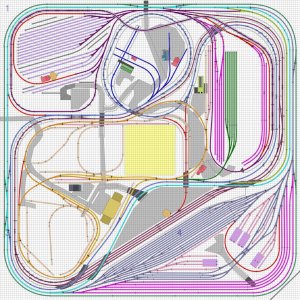You know, I really appreciate seeing a track plan like this because it shows the versatility of this hobby. Some people are in it to develop complex scenes and some are in it just for the fun of running trains. I'm jealous of the amount of track you were able to fit into the given space, but I don't envy you when it comes time to clean it all!
I'm probably sounding like a broken record, but once I put No-Ox on the rails, I haven't had to clean it in well over 1 1/2 years now. It was sometime prior to Christmas before last that I applied it to my mainlines, and I've kept applying it to new track since, and no cleaning has been required except for some unfinished track that went completely unused whatsoever during that time. That's what I'm working on completing now (the orange local line), and I did have to wipe it down vigorously, but just with a dry felt pad.
How are you going to reach all that? How big is the layout?
12' x 12'. To reach a small inner portion of the layout requires crawling under the table to the cutout in the middle. The table's built pretty high, so it's not too bad and I've got foam mats on the floor to save my knees. I have to get in there quite a bit right now for actual construction, but I can reach to pick things up to all but the last foot or so, which means there aren't too many reasons I'd have to go back in there once building is finished. Just the odd derailment in just the wrong place or some other technical difficulty. My trackwork is pretty darn solid, so that shouldn't be an issue too often. I've actually thought of building a big power plant or something on a foam plug to put in the middle once the layout's all done. I can fashion some dangling hooks to hang it on when I do need to remove it for access and it would make the layout look nicer to not have a big hole in the middle.
I had so much benchwork and such around my walls that I just couldn't see putting the layout there and having to do a complete rip-out and re-do of everything, especially since I have power outlets and everything else around the benches. I do have one wall with shelves that I may modify after this part is done, and really do a suburban or even rural leg around there and get into some of the real scenery aspects. I've thought of a line or that would run over and along that wall, then under my big bench (hidden), and come back out to run around the left and top sides of the main layout before heading back into suburbia. I'd have to put one walkthrough, but that's easy enough. So yeah, I'll be building on this guy for a while. And if I get REALLY crazy, I've got a concrete pad I can build another 10x20 room onto

When I started this, I wanted something I could tinker with for years. So far it's been something like 3 years at least, and of course unless you're wealthy something like this takes a lot of time to build up the resources for. Looks like I've got quite a few more years to play with the space I've got before I start getting stir crazy. I have all the mainlines done, all the hot pink tracks in the main yard, I'm now working on the local. After that will be getting the museum/excursion line done along with the bottom portion of the main yard with the engine houses. Then it's just filling in the different yards and maybe starting to tinker with the benchwork for the suburban loop as I wait for turnout money to materialize.


